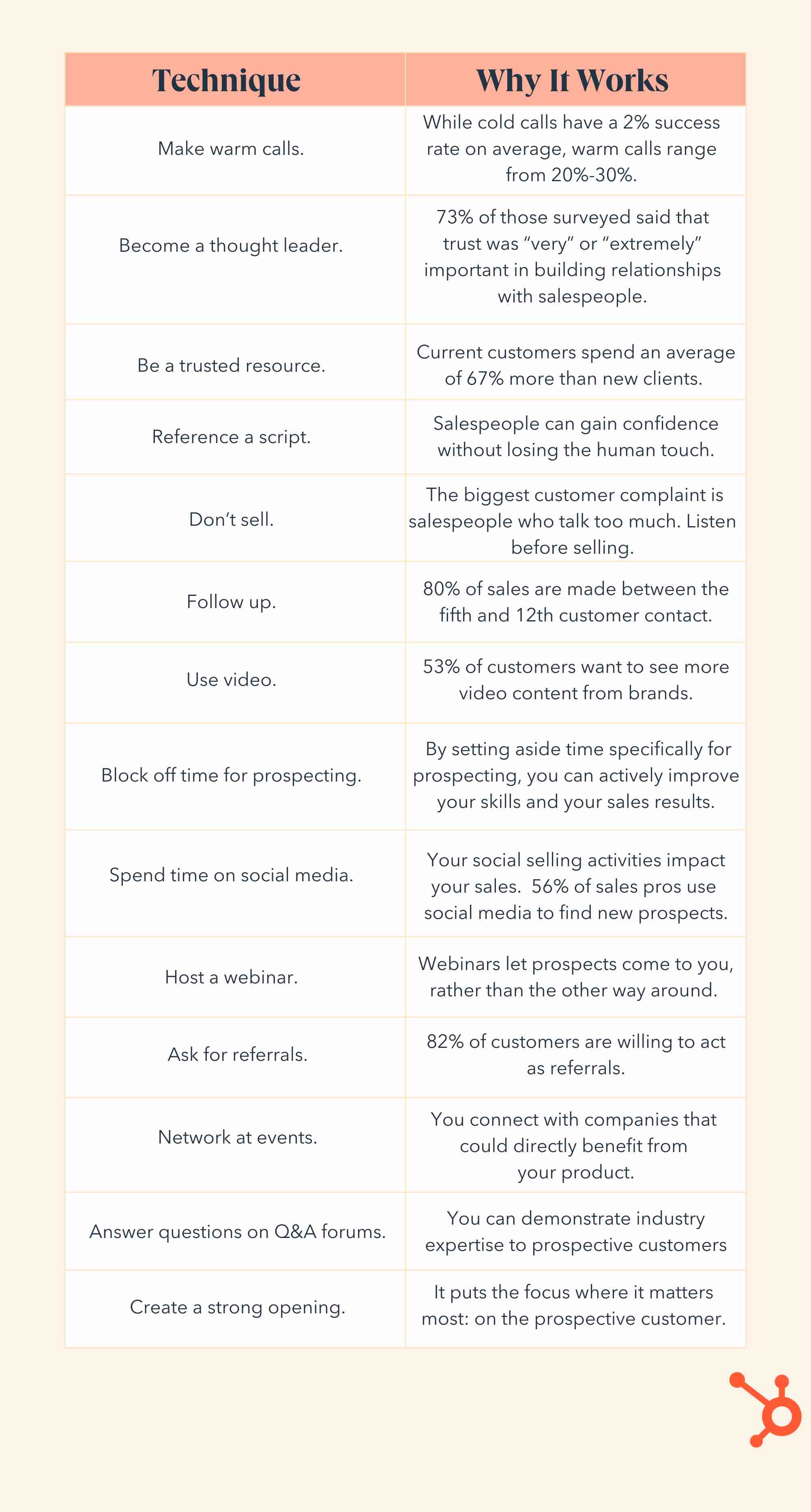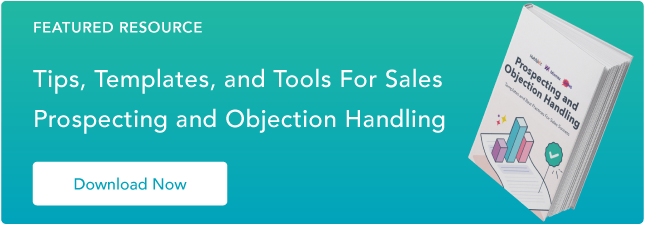Prospecting isn’t easy, but it’s an important part of sales.
Unfortunately, the majority of reps use ineffective and outdated sales prospecting techniques, instead of effective practices that could lead to a higher volume of well-qualified leads.
To help simplify the journey from call to conversion we’ve put together a list of sales prospecting techniques. While we can’t guarantee you’ll see sales success every time, these 14 techniques can make it easier to connect with prospective clients and cultivate new leads.
Sales Prospecting Methods
Sales prospecting methods are how salespeople conduct outreach to source new leads or engage with existing leads. Effective prospecting methods can vary by sales organization and industry. Techniques can include email outreach, social selling, event networking, and warm outreach over the phone.
Traditionally, there were two very different types of prospecting: outbound and inbound.
Outbound was an approach that required the salesperson to conduct “cold” outreach, in which they called and emailed prospects who had not opted into speaking with them.
Inbound sales took the opposite approach, encouraging salespeople to build relationships with their prospects. Inbound organizations call or email only those prospects who had expressed interest in their offering.
Today, most sales experts agree the best approach to sales prospecting is a combination of both inbound and outbound selling.
14 Top Sales Prospecting Techniques
To help streamline your prospecting process, we’ve created a list of 14 top-performing techniques. Read them all for a broad perspective on boosting prospect success, or jump directly to a technique that captures your interest.
- Make warm calls.
- Become a thought leader.
- Be a trusted resource.
- Reference a script.
- Don’t sell.
- Follow up.
- Use video.
- Block off time for prospecting.
- Spend time on social media.
- Host a webinar.
- Ask for referrals.
- Network at events.
- Answer questions on Q&A forums.
- Create a strong opening.
1. Make warm calls.
Your initial contact with new prospects doesn’t have to be — and in fact, shouldn’t be — completely cold. It can be incredibly useful to warm up your prospects before making the initial contact.
By the numbers, these warmer welcomes deliver better sales: While cold calls have a 2% success rate on average, warm calls range from 20%-30%.
You can increase your chances of a warmer reception by familiarizing the prospect with your name or your company affiliation before you make first contact.
A few ideas as to how to achieve this:
- Get introduced by a shared connection.
- Comment on a piece of content the buyer shared on social media.
- “Like” a status update or job change announcement on LinkedIn.
Why this works: Warm calls connect you with prospects that have already expressed interest in your offering or are at the very least familiar with your brand. This makes it much more likely they’ll take time to a least listen to your pitch.
2. Become a thought leader.
By establishing yourself as a thought leader or subject matter expert in your industry, you can establish your credibility and trust before reaching out to new prospects.
This trust is a critical component of effective sales: According to research from Dale Carnegie, 73% of those surveyed said that trust was “very” or “extremely” important in building relationships with salespeople.
Establish yourself as a thought leader by starting a blog, writing guest articles for industry publications, and speaking at trade shows and conferences. This also helps you familiarize your leads with your name before initial contact.
Why this works: The better your industry reputation, the better your chances of connecting with prospects and getting them to consider your product or service.
3. Be a trusted resource.
To be successful as a salesperson, you have to do more than sell. You have to be your client’s go-to person and support them after you’ve closed the sale.
By changing your position from a salesperson to a provider of solutions, you can increase your chance of getting referrals from happy customers.
Draw on these referrals when it comes time for you to introduce yourself to a new prospect. When you become a resource for your clients, before and after the sale, they’ll be willing to help you in return.
This technique also helps drive more revenue over the long term: Data shows that current customers spend an average of 67% more than new clients.
Why this works: Sales aren’t just about short-term success. It’s also about building long-term connections that help drive consistent customer spending over time. Becoming a trusted resource encourages more spending from current clients and helps drive organic referrals.
4. Reference a script.
For new salespeople, referencing a basic script while prospecting can help them reduce uncomfortable pauses, use the right language, and respond to common objections.
Experienced, seasoned sales representatives often recommend not using a script in order to sound more natural during conversations. However, some do still use a script. It’s just so ingrained in their minds that it comes out sounding natural and unrehearsed.
Whether you use a script or not, make sure to actively listen to your prospects and customize your conversation based on their needs.
Why this works: By using a script as an outline for talking points — rather than a must-follow list of questions or comments — salespeople can gain confidence without losing the human side of the sales interaction.
5. Don’t sell.
Prospecting is the first step in selling, but in and of itself, it is not selling. It’s about sourcing leads who can then be qualified and entered into the sales funnel. Only once these steps have taken place can the selling begin.
If you want to be successful in today’s sales environment, you need to focus on building relationships while prospecting. Start selling too quickly and you’ll put undue pressure on the prospect.
In fact, the biggest customer complaint is salespeople who talk too much and don’t listen enough — something that’s been true for more than four decades.
Building a foundation of trust can help you and the prospect become more comfortable with each other, so once selling techniques come into the picture, they’ll be more effective.
Why this works: While it may seem counterintuitive to not sell your product ASAP, you’ll see more success in building relationships first. Not only does trust encourage eventual purchasing, but can keep customers coming back.
6. Follow up.
Keep the prospect in the loop and follow up at each step of the deal. Whether you’re confirming a time for your next meeting or sending over additional resources, an email or call helps you build a relationship with your point of contact.
This allows you to further establish yourself as a trusted resource for the prospect, rather than simply following up with “just checking in.“
With 80% of sales made between the fifth and 12th customer contact, it’s in your best interest to circle back and make sure you stay in touch with prospects.
Why this works: Following up shows commitment and drive, especially if you’re offering more than just another sales pitch. Building a relationship takes time and effort. Following up shows that you’re willing to put in the work.
7. Use video.
Make your outreach even more enticing to prospects by including a video. Use it to introduce yourself, provide additional content, or recap your connect, discovery, or qualification call.
Capture the prospects’ attention by adding “video” in the subject line and including a thumbnail image that links to the video.
Why this works: 53% of customers want to see more video content from brands, and 62% of customers say they pay close attention to videos, compared to just 27% for blog articles. In other words? Seeing is believing when it comes to sales prospecting.
8. Block off time for prospecting.
Prospecting isn’t easy. More than 40% of salespeople say it’s the most challenging part of the sales process. That’s why you need to set aside dedicated prospecting time on your calendar each day.
By blocking off time to prospect, you’ll be better off in the long run. You’re actively filling your pipeline, which often results in more conversations and better win rates.
Why this works: It’s easy to avoid what you don’t like doing. By setting aside time specifically for prospecting, you can actively improve your skills and your sales results.
9. Spend time on social media.
Implement a social selling strategy and meet prospects wherever they are. A fair amount of people who’ve researched your product are active on social media (e.g., Twitter, LinkedIn, Facebook, etc.). Answer their questions and share content that’s relevant to their research.
.jpg?width=882&height=1026&name=sales-prospecting-tips-social (1).jpg)
Image Source
Your social selling activities can have a positive impact on your sales. Today, 56% of sales professionals use social media to find new prospects. Facebook, LinkedIn, Instagram, YouTube, and TikTok all offer prospecting opportunities, depending on your target market and sales strategy.
Why this works: Effective prospecting is all about finding and courting your target audience. Given the diversity of potential clients on social media, salespeople have a greater chance of finding customer segments that align with sales strategy goals.
10. Host a webinar.
Webinars are a perfect place to source leads because you know the attendees have a demonstrated interest in the topic. Partner with another organization in your industry to host a webinar on a mutually beneficial topic.
-jpg.jpeg)
Image Source
After the webinar, poll your audience to see who’s ready to learn more about your product/service. Consider a polling form that asks them to answer “Yes” or “No” to statements like “I’m ready for a demo,” or “I’d like to learn more about [Your company name.]“
Follow up with those who responded positively to your poll or post-webinar survey within 24 hours, and schedule time for them to learn more.
Don’t give up on those who said they weren’t yet ready to buy. Place them into nurture campaigns, and stay in touch over the next few months to see if their buying position changes.
Why this works: Webinars let prospects come to you, rather than the other way around. They’ve already demonstrated an interest in what you offer. All you need to do is capitalize on this interest with post-webinar follow-up.
11. Ask for referrals.
If you’re not asking for referrals, you’re leaving yourmost reliable prospecting well untapped. Once you’ve successfully closed new business, ask your prospect or champion if there’s anyone in their professional network you might connect with.
It’s also a good idea to use follow-up communications over the next few months as another moment in which to ask for new connections.
For example, after your customer has onboarded (and is happy with their experience) ask, “I’m so glad you’re already finding value in Sunrise Staffing Software Solutions. Is there anyone in your professional network who might also benefit from chatting with us?“
Why this works: Data shows that after a positive brand experience, 82% of customers are willing to act as referrals, but just 29% make the effort. Why? Because no one asked.
12. Network at events.
First, find the right events to attend. Identify why people are attending a certain conference, if the agenda has topics relevant to your ideal customer, what the size of the community is, and the overall purpose of the event.
If you sell project management software to entry- and mid-level designers, you might want to avoid a conference targeted toward design leaders or creative directors who aren’t in the weeds with the types of software their designers are using.
Once you identify the events that will give you the greatest ROI, map out which sessions you’ll attend, which happy hours or networking events you’ll work on, and whether or not your company will have a booth or speaking presence there.
Why this works: This is the physical version of digital social selling. Instead of posting online, you’re putting boots on the ground and connecting with companies that could directly benefit from your product. However, remember the goal is relationship building, not sales. Do the first part well and the second naturally follows.
13. Answer questions on Q&A forums.
Seek out ways to educate your audience on trends and best practices in your industry — and eventually educate them on your product.
 (1)-jpg.jpeg)
Image Source
Online forums, like LinkedIn Groups and Quora, allow like-minded people to post questions to the group members or audience and source answers from experts in the field. Join these platforms, and start by listening.
Get used to how people pose questions, review what is and is not allowed, and chime in on a few conversations before answering questions yourself. Once you’ve built some clout in the community, identify questions you can answer without bias.
For example, if you sell machinery for large agricultural operations, you might answer a question someone asks about the impact of AI on farming.
Why this works: Expertise engenders trust. If you can demonstrate industry expertise to prospective customers, you can help drive conversations about specific products or services and make the sale.
14. Create a strong opening.
You only get one chance to make a first impression, so you better make it count.
This is especially true in sales prospecting, since the person you’re calling (warm or cold) may not be particularly interested in what you’ve got to say. As a result, it’s worth creating a strong opening line that captures attention and makes it more likely that contacts will want to keep the conversation going.
Best bet? Open with something about them, not about you.
For example, find an article they’ve written recently or look into the work they’ve been doing based on their LinkedIn profile. Offer praise for something they’ve done or interest in something they’ve said, and then take a minute or two to actually explore what you think of their work.
Here’s why: With the volume and frequency of digital and phone-based sales calls increasing, prospective customers can easily spot efforts that are simply a means to an end. While a strong opening helps, be ready to back it up.
Why this works: This approach works because it puts the focus where it matters most: on the prospective customer.

Improving Your Prospective Potential
Sales prospecting isn’t easy. Finding, calling, and engaging with potential buyers can be a daunting and time-consuming task.
While it’s not possible to entirely remove the challenges that come with sales prospecting, it is possible to improve potential outcomes with the right approach to contacts, calls, and continuing communication.
Editor’s note: This post was originally published in November 2015 and has been updated for comprehensiveness.

![]()


![Read more about the article Two Successful Approaches to Account Planning [Template]](https://www.dimaservices.agency/wp-content/uploads/2021/11/c444f9f2-9037-4618-bd04-1203c39068aa-300x39.png)
